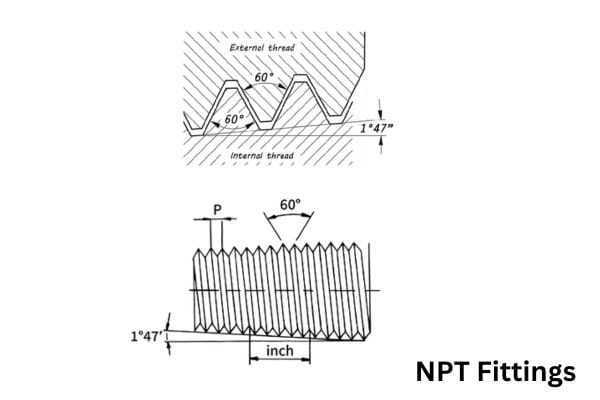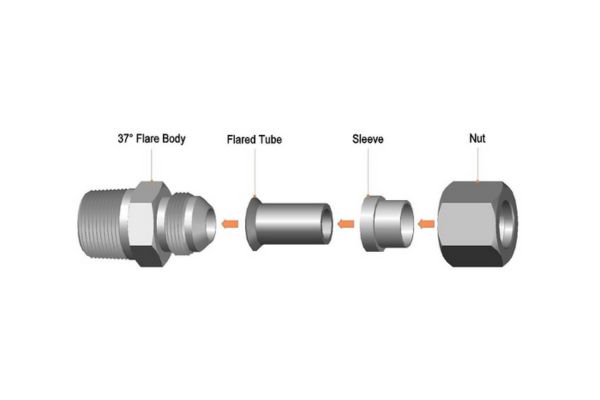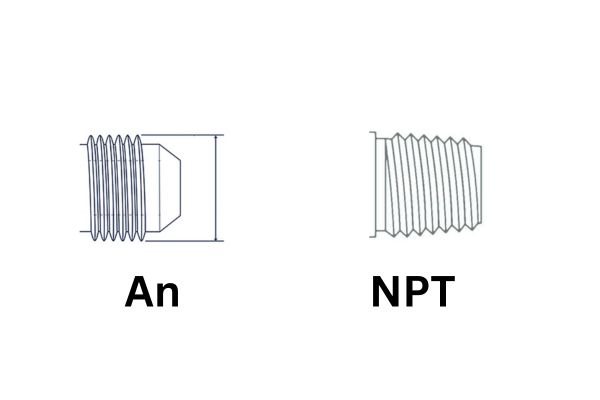Without the proper fittings, hydraulic systems can suffer from leaks, pressure drops, and even catastrophic failures, which can lead to significant downtime and increased maintenance costs. The purpose of this article is to provide a detailed comparison of NPT and AN fittings, highlighting their respective advantages and disadvantages, and ultimately guiding you in choosing the right fitting for your specific hydraulic system needs.
NPT, which stands for National Pipe Taper, is a U.S. standard for tapered threads used on threaded pipes and fittings. These fittings were developed to ensure a standardized method of joining and sealing pipes and fittings in various industrial applications. The tapering of the threads helps to create a tighter seal as the threads are tightened, which has made NPT fittings a reliable choice for many industries since their inception in the early 20th century.
NPT fittings are designed with specific characteristics that make them distinct and effective for certain applications. One of the most notable features is the tapered threads, which decrease in diameter from the base of the thread towards the end. This tapering effect helps to form a seal by wedging the male and female threads together as they are tightened, thereby preventing leaks.

NPT fittings are manufactured from a variety of materials to accommodate different environments and application requirements. Common materials include:
NPT fittings come in a wide range of sizes to fit various pipe diameters. The sizes are typically denoted by the nominal pipe size (NPS) and range from very small diameters, such as 1/8 inch, to much larger diameters, such as 6 inches or more.
NPT fittings are widely used across numerous industries due to their versatility and reliability. Some of the typical applications and industries include:
AN fittings, short for Army-Navy fittings, were originally developed for military applications during World War II to meet the high standards required for aircraft and aerospace use. These fittings have since become popular in various industrial and automotive applications due to their precision and reliability. AN fittings are designed to provide a leak-proof seal in high-pressure environments, which makes them ideal for hydraulic systems and other fluid transfer applications.

AN fittings are characterized by several unique design features that contribute to their effectiveness and versatility.
AN fittings are manufactured from a variety of materials to suit different applications and environments. Common materials include:
AN fittings come in a range of sizes, typically designated by a dash number that corresponds to the outer diameter of the tubing in sixteenths of an inch. For example, a -4 AN fitting would be suitable for tubing with an outer diameter of 1/4 inch.
AN fittings are widely used across various industries due to their high reliability and performance in demanding conditions. Some typical applications and industries include:
Tapered vs. Straight Threads
Thread Engagement and Sealing Methods

Ease of Installation
Tools Required
Maintenance Considerations
Feature | AN Fitting | NPT Fitting |
Thread Type | Straight thread + 37° flare seal | Tapered thread |
Sealing Method | Mechanical flare / O-ring | Thread engagement + sealant (e.g., PTFE tape) |
Reusability | Highly reliable | Prone to wear and leakage |
Standard | SAE J514 | ASME B1.20.1 |
Installation | Precision fit / Torque controlled | Simple but prone to overtightening |
Maximum Pressure Ratings
Performance in High-Pressure Applications
Chemical Compatibility
Temperature Range
Choosing between NPT and AN fittings for your hydraulic system involves evaluating several critical factors to ensure optimal performance, reliability, and cost-effectiveness. Here, we explore the key considerations and provide a decision-making checklist to guide you through the selection process.
System Requirements and Specifications
Environmental Conditions
To ensure you make the right choice between NPT and AN fittings, consider the following key questions:
Ensure the fittings can handle the highest pressures and temperatures they will be exposed to.
Verify that the fittings will not impede the system’s flow rate.
Choose materials that are resistant to corrosion and degradation by the hydraulic fluid.
Select fittings that can withstand the specific environmental conditions of your application.
Consider the time and effort required for installation and ongoing maintenance.
AN fittings may be preferable for applications where long-term reliability and minimal maintenance are crucial.
Evaluate the overall cost-effectiveness of the fittings over their expected lifespan.
In summary, selecting the right fitting for your hydraulic system is crucial for ensuring optimal performance, reliability, and longevity. When choosing between NPT and AN fittings, it is essential to consider your system’s specific requirements, including pressure ratings, flow rates, material compatibility, and environmental conditions. Assess the ease of installation and maintenance needs, and evaluate the overall cost of ownership. By carefully weighing these factors, you can make an informed decision that best meets your hydraulic system’s needs.
NPT fittings have tapered threads and rely on sealing compounds, while AN fittings have straight threads and a 37-degree flared sealing surface for a metal-to-metal seal.
AN fittings are generally better suited for high-pressure applications due to their superior sealing capabilities and higher pressure ratings.
No, AN fittings do not require Teflon tape. They achieve a leak-proof seal through the metal-to-metal contact of the flared surfaces.
NPT fittings can be easier to install due to their tapered threads and the use of sealing compounds, while AN fittings require precise alignment and specific tools for proper installation.
AN fittings are commonly made from aluminum, stainless steel, brass, and titanium, depending on the application and environmental conditions.
NPT fittings may require more frequent maintenance to re-tighten or re-seal connections, while AN fittings typically require less frequent maintenance due to their durable metal-to-metal seal.